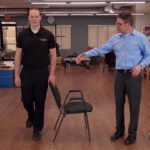One-Leg Standing | Early Intervention Ergonomics
What is the One-Leg Standing Exercise?
The one-leg standing exercise, also known as the single-leg stance, is a balance exercise that involves standing on one leg while maintaining stability. It is a simple yet effective exercise that helps improve balance, coordination, and overall lower body strength.
To perform the one-leg standing exercise, follow these steps:
- IMPORTANT: In order to maintain safety, make sure to use a sturdy chair or countertop to lightly hold onto during this exercise in order to maintain your balance.
- Stand tall with your feet shoulder-width apart and arms by your sides.
- Choose one leg to start with and slightly lift the other leg off the ground, bending it at the knee.
- Find a focal point in front of you and focus your gaze on it to help maintain balance.
- Engage your core muscles and maintain an upright posture throughout the exercise.
- Hold this position for about 60 seconds.
Remember to perform the exercise on both legs to ensure balance development on both sides of the body.
Early Intervention Benefits
The one-leg standing exercise, offers several early intervention benefits, primarily focusing on balance, stability, and lower body strength. Here are some of the key benefits:
- Balance improvement: Performing the single-leg stance challenges your body’s ability to maintain stability on one leg. By practicing this exercise regularly, you can enhance your balance and proprioception, which is your body’s awareness of its position in space. Improved balance is essential for daily activities, sports performance, and fall prevention, particularly for older adults.
- Core muscle activation: Balancing on one leg requires significant engagement of the core muscles, including the abdominal muscles, lower back muscles, and hip stabilizers. These muscles work together to maintain a stable and upright posture during the exercise. Over time, this can lead to improved core strength and stability.
- Lower body strength development: The single-leg stance targets the muscles in the standing leg, including the quadriceps, hamstrings, glutes, and calf muscles. These muscles are responsible for maintaining the position and supporting your body weight during the exercise. By regularly performing the single-leg stance, you can strengthen these muscles, which can improve overall lower body strength and stability.
- Injury prevention: Strengthening the muscles involved in balance and stability can help reduce the risk of falls and injuries, particularly in activities that require single-leg support, such as running, jumping, and changing directions quickly. By practicing the single-leg stance, you can improve your body’s ability to handle the demands of these activities, decreasing the likelihood of accidents.
- Rehabilitation and injury recovery: The single-leg stance is often used in physical therapy and rehabilitation programs to help individuals recover from lower body injuries, such as ankle sprains or knee injuries. By gradually reintroducing weight-bearing and challenging balance, the exercise aids in restoring stability, strength, and confidence in the injured limb.
Things to Remember
As with any exercise, it’s important to listen to your body and avoid pushing beyond your limits. If you have any concerns or pre-existing medical conditions, it’s recommended to consult with a healthcare professional before starting a new exercise routine.
It’s important to note that individual results may vary, and it’s always recommended to consult with a healthcare professional or a qualified fitness trainer before starting any new exercise program, especially if you have pre-existing medical conditions or concerns. They can provide personalized guidance and adapt the exercise to your specific needs and abilities.
These early intervention exercises are to improve overall health and fitness as well as reduce work-related injuries.
Remember: If you have an injury or illness, consult with a health care professional before attempting.
More Tools & Resources from Peak Ergonomics
Contact Us About Reducing Workplace Injuries
Healthy Employees are the Bottom Line! – Learn More!

